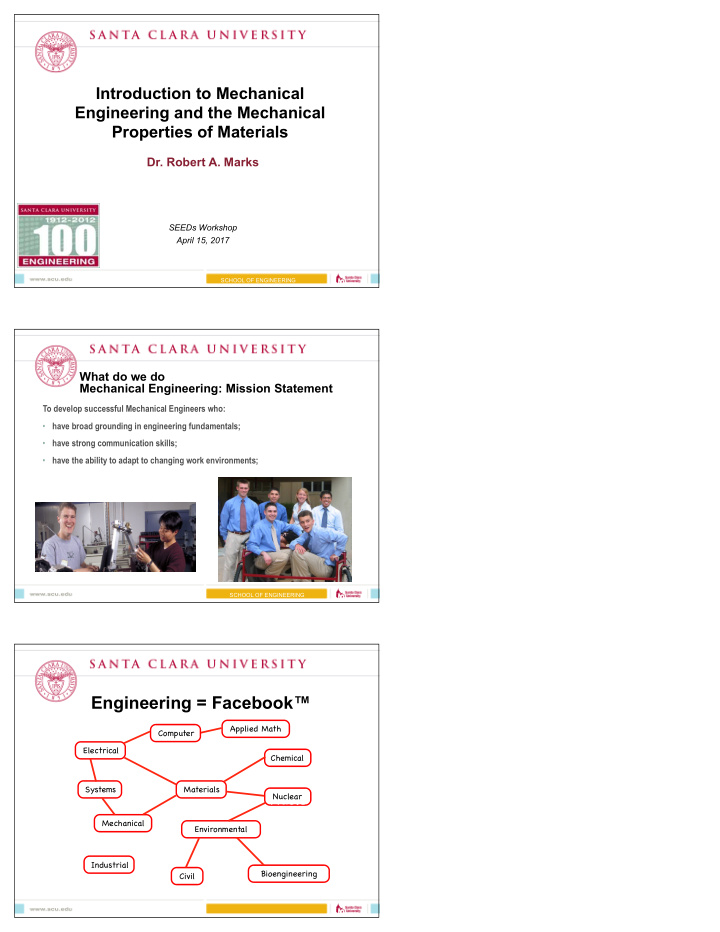



Introduction to Mechanical Engineering and the Mechanical Properties of Materials Dr. Robert A. Marks SEEDs Workshop April 15, 2017 SCHOOL OF ENGINEERING What do we do Mechanical Engineering: Mission Statement To develop successful Mechanical Engineers who: • have broad grounding in engineering fundamentals; • have strong communication skills; • have the ability to adapt to changing work environments; SCHOOL OF ENGINEERING Engineering = Facebook™ Applied Math Applied Computer Electrical Chemical Chemi Systems Materials Nucle Nuclear Mechanical Environmental Indust Industrial Bioengineering Civil SCHOOL OF ENGINEERING
Mechanical Engineering at SCU Summer 2014 School of Engineering e-news SCHOOL OF ENGINEERING 2014 Freshman Admission Profile Acceptance rate 49.3%, 1319 enrollment – 50% male, 50% female Admitted students for the Fall 2011 had the following average scores: – ACT Composite (25 th to 75 th percentile) 27-32 – SAT Critical Reading 590-680 – SAT Math 620-710 – GPA 3.67 Expenses – Tuition $43,812 – Room and board $12,921 SCHOOL OF ENGINEERING 2014 Freshman Engineering Admission Profile Demographic data for students enrolled for – Admission rate 51.2% – Female (2011) 28.0% – Male (2011) 72.0% Admitted students for the 2014 had the following average scores: – ACT Composite 30-34 – SAT Critical Reading 620-690 – SAT Math 670-750 – SAT Composite 1,300-1430 – GPA (2011) 3.75 ASEE Profiles 2014, institutional research SCHOOL OF ENGINEERING
Mechanical Engineering at SCU KEY TOPICS Dynamics & Dynamics & Vibrations Vibrations Fluid Flow & Heat Transport Fluid Flow & Heat Transport Controls, Robotics, & Mechatronics Controls, Robotics, & Design & Manufacturing Mechatronics Design & Manufacturing Babbage’ s Difference Engine (designed in 1849, first built in 2002) SCHOOL OF ENGINEERING Mechanical Engineering at SCU GRADUATE UNDERGRADUATE Thermofluids Dynamics & Dynamic Systems Vibrations Senior Design Projects Robotics/Mechatronics Human Power Vehicle Mechanical Design Fluid Flow & Omoverhi: low-cost incubator Materials Engineering Heat Transport NanoSat Controls, Robotics, & Solar Tracker Mechatronics Solar Water Distiller Design & Solar Decathlon (DoE) Manufacturing SCU: 3rd Place (2007 & 2009) SCHOOL OF ENGINEERING Mechanical Engineering at SCU SCHOOL OF ENGINEERING
Jobs for Mechanical Engineers Aerospace/Defense Automotive Silicon Valley Chemical Mechanical Planarization Robots in semiconductor manufacturing equipment Thermal Management of Computing Systems Google™ uses enough power to continuously power 200,000 homes (NY Times 9/8/11) SCHOOL OF ENGINEERING Life after Santa Clara Survey of 2013 Graduates SCHOOL OF ENGINEERING Materials Science • Bridge between “Science” and “Engineering” • May be called any of the following: -Materials Science -Materials Science and Engineering -Materials Engineering • Often combined with Chemical or Mechanical Engineering departments • Most Engineering students are required to take at least one introductory course in materials
Materials Science MICROSTRUCTURE PROCESSING PROPERTIES A TOMIC B ONDING IN S OLIDS : Ionic: electrostatic attraction of opposite charges Covalent: electron sharing ( e.g. , diamond and silicon) Metallic: free electron model a.k.a. “sea of electrons” D EFORMATION OF M ETALS : •Elastic Region: stretching 4$.,&'%*2"3'() of atomic bonds (similar to 0(+%" springs) •Plastic Region: permanent 1$.,&'%*2"3'() deformation...WHY??? -Dislocations !"#$"%&'()*(+*!',-$.%"/")&
S TRAIN H ARDENING IN M ETALS : •Higher force needed for continued plastic deformation •Dislocation movement becomes more difficult as deformation proceeds •Dislocations get “tangled” up with one another and it becomes harder for them to move, so more force is required to continue deforming the metal. In a heavily deformed metal, there can be as much as ≈ 10 12 cm of dislocation line per cm 3 of material. 10 12 cm = 10 7 km ≈ 25 × distance to the moon M ICROSTRUCTURE IN S OLIDS : •Solids formed from solidification; this leads to many micro-crystals called grains. •Difficult for dislocations to cross a grain boundary •By cooling faster, smaller grains are formed •When a solid is heated, large grains grow at the expense of smaller grains. •Stretching of atomic bonds is S UMMARY : reversible and occurs during elastic deformation. •Dislocation motion is irreversible and leads to permanent or plastic deformation. •Solids are usually composed of several microscopic crystals known as grains. •The size of grains increases (grain growth) when a solid material is exposed to higher temperatures. •Dislocation motion is impeded by grain boundaries; hence, smaller grained metals tend to be more difficult to deform plastically. Image by: S ETH T. T AYLOR , Nature Materials , 3 682 (2004).
2017 SEED S Dr. Marks M ECHANICAL P ROPERTIES OF M ATERIALS L AB W ORKSHEET 1) Write the names of your group members below. 2) Write the letter of your brass sample here . 3) Write the hardness values you measured for your sample below. 4) After consulting with the other members in your group, write the temperature at which each sample was annealed (500°C, 600°C, 700°C, or 800°C) below. Sample A Sample B Sample C Sample D 5) Which sample do you expect to have the smallest grain size, and which sample do you expect to have the largest grain size? smallest grains largest grains (A, B, C, or D) (A, B, C, or D) 6) On the back of this page, briefly explain how you came to your conclusions for 4) and 5).
Recommend
More recommend